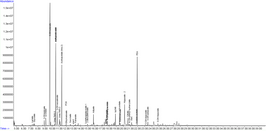Urine organic acids
| Urine organic acids | |
|---|---|
| Purpose | measures organic acid metabolites in urine |
Urine organic acids is a medical diagnostic test that measures organic acid metabolites in the urine. The metabolites can come from host cells or from flora. The test can be used to exclude the possibility that a person has an inborn error of metabolism, usually one of the organic acidemias. It is also used to look for problems with nutrition or evidence of certain infections or bacterial overgrowth. The usual method of analysis is tandem mass spectrometry.[1]

References[edit]
- ^ Jones, P. M.; Bennett, M. J. (2010). "Urine Organic Acid Analysis for Inherited Metabolic Disease Using Gas Chromatography-Mass Spectrometry". Clinical Applications of Mass Spectrometry. Methods in Molecular Biology. Vol. 603. pp. 423–431. doi:10.1007/978-1-60761-459-3_41. ISBN 978-1-60761-458-6. PMID 20077094.
